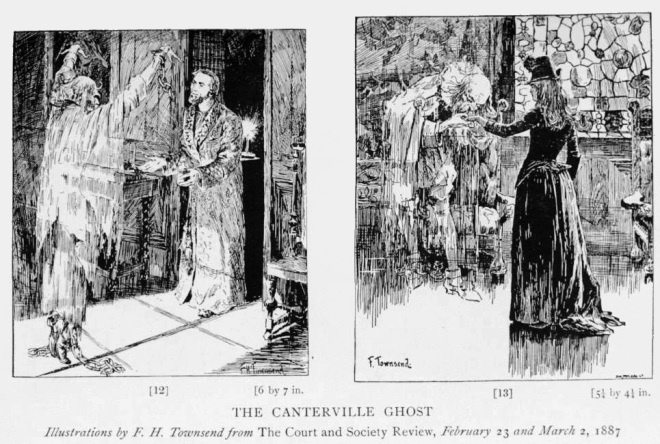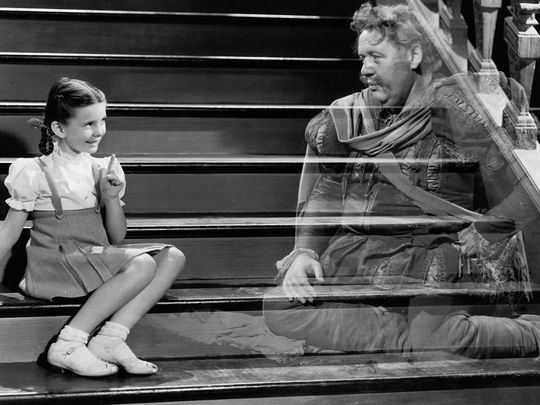The Canterville Ghost is a very silly Victorian Ghost story that Oscar Wilde released in two parts, in 1887. It was the prolific author’s first published story. It sets the tone for a huge swathe of horror comedies that feature a very ineffectual haunting. The humorous ghost story is a strange literary creature that subverts expectations and has become somewhat of a cliche. But in a time when the supernatural was given more mainstream credence this disarming use of humour would have had a very different effect on the reader.
Not only did Oscar Wilde release his first story during the final gasps of the romantic movement and at the birth of modernity, but he released the story during the rapid spread of the spiritualism movement. Ghostly spectres and powerful intangible phantoms were actively sought out by interested parties, and it was terribly fashionable to hold seances and be informed of the symbolism of the spiritual realm. It is a story that perfectly encapsulates the way in which Wilde’s work is transitional between the romantic and modern literary movements.

Who is the Canterville Ghost?
The American Otis family are told upon buying Canterville Chase in England, that the estate is haunted. The ghost has terrified the Canterville family for decades and is often an omen that appears before the death of a member of the family. The Otis family refuse to believe that there is anything supernatural about their new home.
They are of course wrong.
Sir Simon, the former occupant of the house who killed his wife then disappeared makes his presence felt through a blood stain that will not fade and physical apparitions. He has a huge variety of haunting tools and visages at his disposal, such as representing himself as a headless spectre, he has also been previously known to physically injure his victims. Even scaring some to death.
But the new inhabitants of the chase, however, turn this terrifying phantom into a grumpy, exhausted and battered creature who no longer stalks the corridors, rather shuffles along in slippers and warm clothes to combat the chill from drafts.
I’m unsure as to whether Sir Simon is the first of his kind, in being a formerly formidable spectre who is rendered impotent by the materialism and pragmaticism of modernity.
What is different about the Otis family?
Through the oiling of noisy chains and the cleaning of ominous, reappearing “blood” stains, the Otis family undermines every artifice of haunting that the ghost has at his disposal. Even the hauntings that he manages to pull off are laughed at by the twins or entirely backfire due to the twin’s concerted efforts to torture the ghostly spectre of Sir Simon who has haunted generations of British nobility and their servants. It seems to be their dissociation from the realm of English folklore which grants them immunity from the ill effects of the spiritual realm.
Virginia is the only member of the family who comes even close to a classical gothic character of the human realm. She is vulnerable to the haunting similar to the British characters, however, her link to her modern American family seems to have kept her safe from the more horrific aspects of the haunting. Her strength of character and depth of understanding makes her the ultimate foil to Sir Simon’s legacy of terror. Sir Simon confides in the young girl, giving her the tools to stop the haunting and free the dead nobleman once and for all.
Perhaps the ghost realises that he is no longer relevant as he beholds the modern American family, which, let’s face it, Wilde portrays as grotesque in their own way. Is Wilde bemoaning the loss of gothic romanticism and folkloric tradition and the hands of the crude family? Or is he celebrating the modern thinking of the American people who are untethered to the restrictive tradition of the British Isles?

How on earth are you going to connect this one to Frankenstein?
I have had a bit of a think about this and maybe the strongest of the tangential threads that connect Frankenstein or the Modern Day Prometheus to the Canterville Ghost is the collision between the romanticism of the 19th-century horror story and the critical thinking and scientific reasoning that was emerging before Mary Shelley put pen to paper. Shelley’s narrative is still firmly entrenched in the lore of ages past, but her Doctor is a man of science and the spectre of her novel is a being of undead science. Conversely, Wilde’s spectre Sir Simon is still firmly placed in traditional gothic ideas of the ghost, but the narrative is a distinctly modern one.
In short, I’m going to go ahead and say that both narratives deal with the juxtaposition of the romantic gothic novel and an increasingly pragmatic and modern reality.
